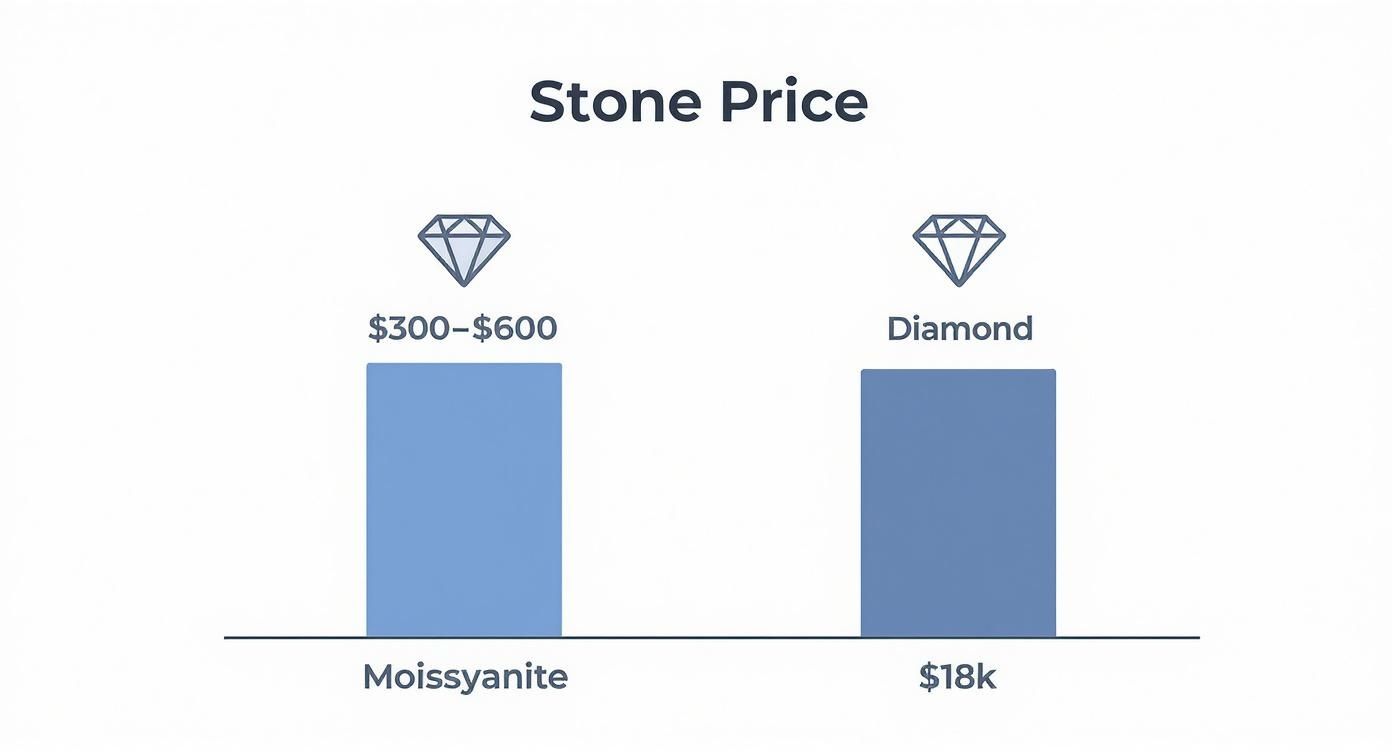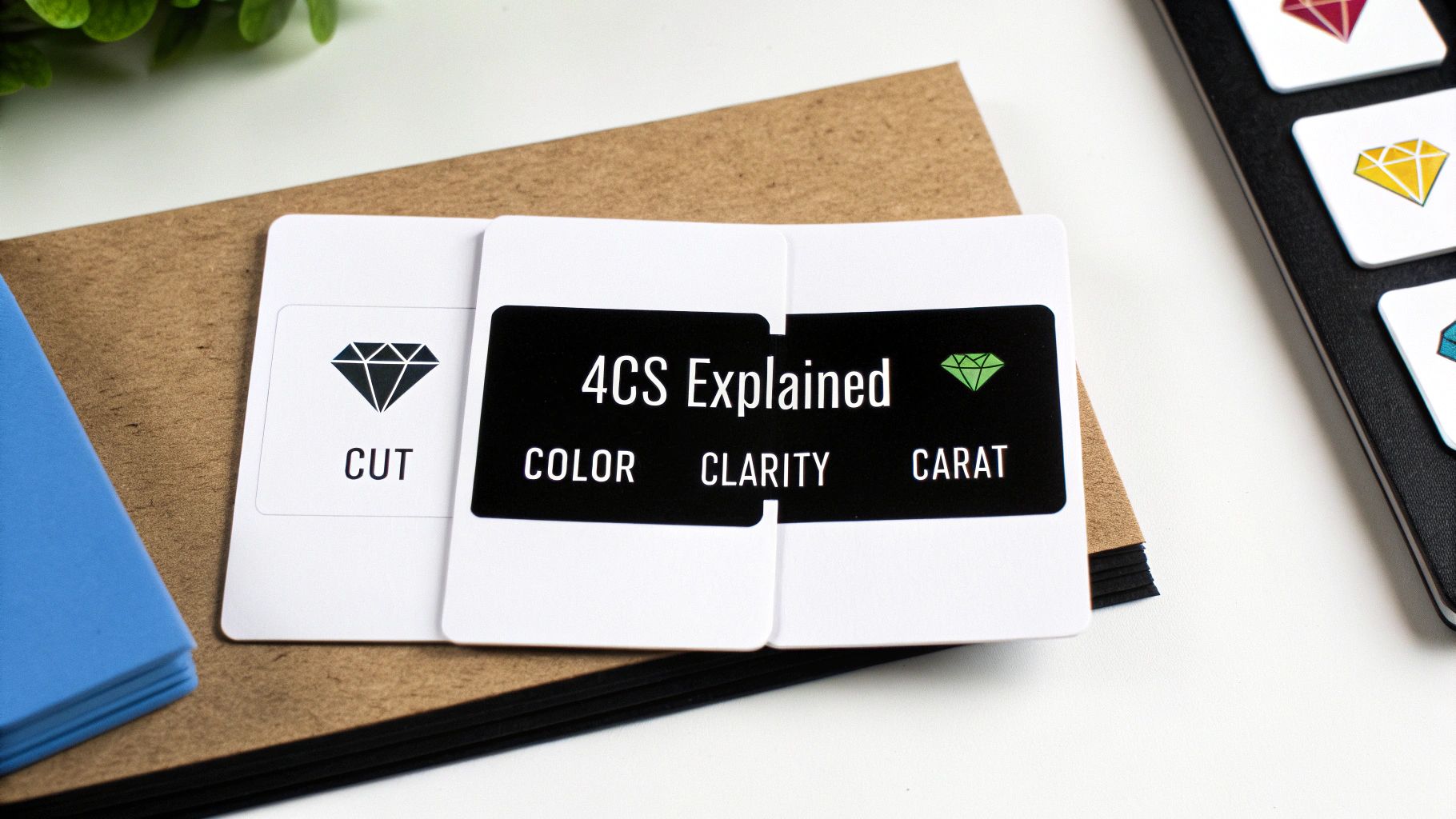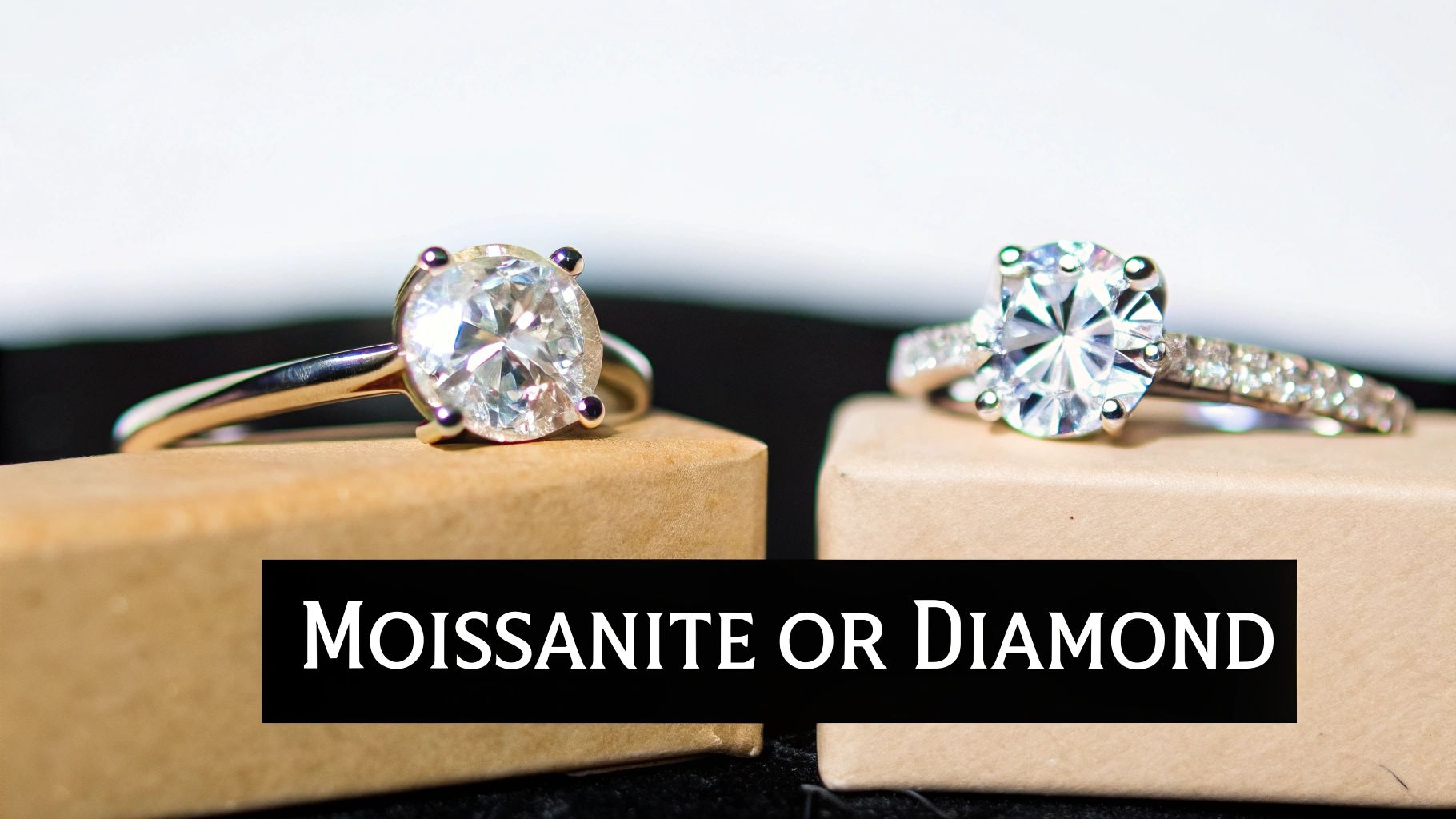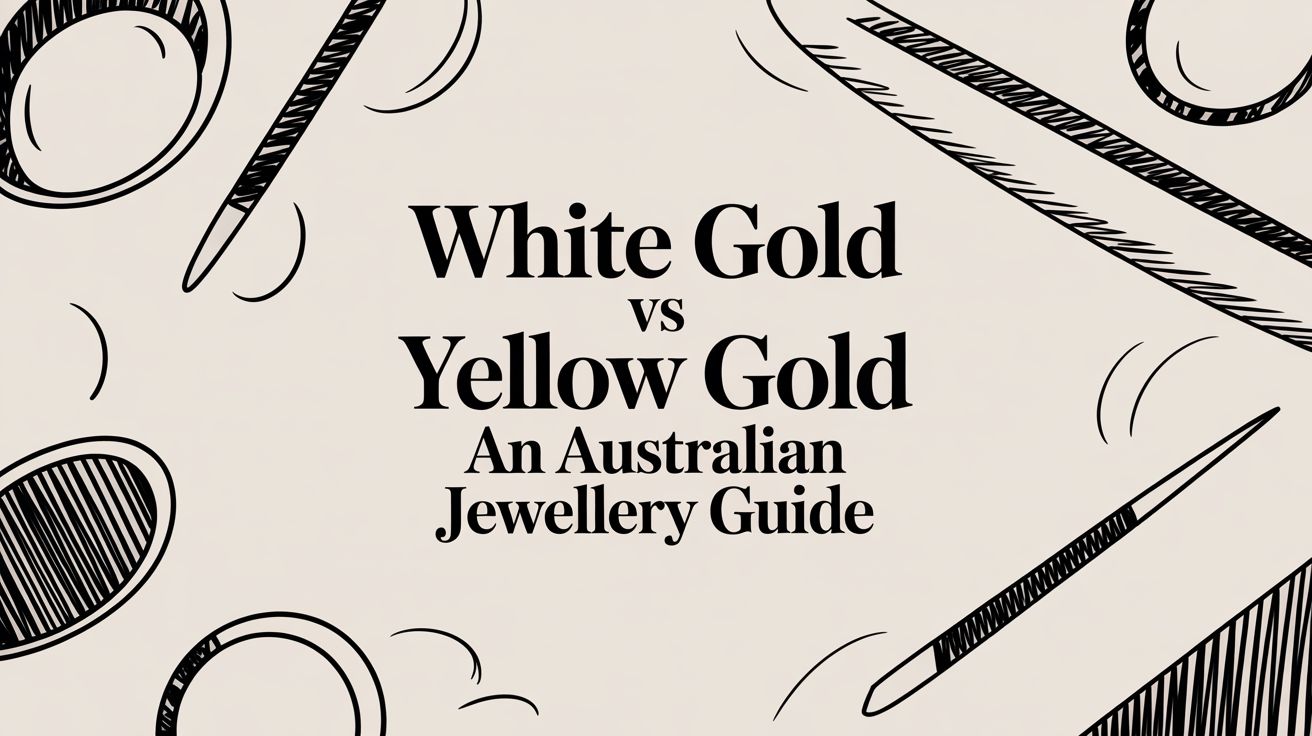When it comes to the moissanite vs diamond price debate, the difference isn't just noticeable—it's one of the biggest factors for most buyers. A stunning, high-quality moissanite costs just a tiny fraction of a natural diamond that looks virtually identical to the naked eye. This massive price gap means you can get a much larger, more brilliant stone for your budget, without compromising on beauty or durability.
An Immediate Look at the Price Difference
So, why the huge cost disparity? It all comes down to how they’re made. Natural diamonds are a finite resource, pulled from deep within the Earth through a very expensive and difficult mining process. Their rarity is a huge driver of their value.
Moissanite, on the other hand, is a gemstone born in a lab. It’s created from silicon carbide in a controlled, efficient process that completely sidesteps the logistical and ethical headaches of mining. This core difference in origin and supply chain is passed directly onto the final price tag.
Here in Australia, you really see the gap. A 1-carat natural diamond can set you back anywhere from AUD $2,500 to over AUD $18,000, all depending on its quality. A visually comparable 1-carat moissanite? You're looking at between AUD $300 and AUD $600. That means you can get a beautiful moissanite for roughly 5% to 10% of a natural diamond's price. You can read more about the cost-effectiveness of moissanite rings here.
The value of moissanite isn't found in resale potential but in the immense upfront savings. It delivers the "wow" factor of a large, brilliant gemstone for a budget that would typically only afford a much smaller diamond.
Let's break that down into a simple, at-a-glance comparison.
Quick Price Comparison 1-Carat Stone (AUD)
This table gives you a clear snapshot of the average cost for a 1-carat stone on the Australian market. The savings with moissanite are impossible to ignore.
| Stone Type | Typical Price Range (1-Carat) | Approximate Percentage of Diamond Cost |
|---|---|---|
| Natural Diamond | $2,500 – $18,000+ | 100% |
| Moissanite | $300 – $600 | 5% – 10% |
Looking at the numbers side-by-side, it’s easy to see why moissanite has exploded in popularity, especially for engagement rings. It opens the door to getting the exact ring you’ve dreamed of, without the financial pressure that often comes with buying a natural diamond.
Ultimately, the right choice depends on what you value most. Are you drawn to the tradition and natural origin of a diamond, or is the incredible sparkle-per-dollar that moissanite offers more appealing? For anyone focused on achieving a specific look within a set budget, the moissanite vs diamond price discussion often ends right here.
Breaking Down the Cost Per Carat
When you're weighing up moissanite versus a diamond, looking at a single 1-carat stone only gives you a glimpse of the full picture. The real story, and the most dramatic difference in cost, unfolds as the gemstone gets bigger. This is all down to the fact that diamond and moissanite prices scale in completely different ways.
A natural diamond’s price grows exponentially with its carat weight. Think of it this way: a 2-carat diamond isn't just double the price of a 1-carat of the same quality; it's often three, four, or even five times more expensive. That’s because large, high-quality diamonds are incredibly rare, and their price tag is a direct reflection of that scarcity.
Moissanite, on the other hand, follows a much more predictable and linear pricing path. Because it’s created in a controlled lab environment, making a 2-carat stone isn’t drastically harder than making a 1-carat one. The result is that its price goes up in a much more straightforward, manageable way as it gets bigger.
The Impact on Your Budget
This is where things get really interesting for you as a buyer. This fundamental difference means your budget goes a lot further with moissanite, allowing you to get a much larger, more visually impressive stone than you could with a diamond.
For example, the money you'd set aside for a nice but modest 1-carat natural diamond could easily secure a show-stopping 2-carat or even 3-carat moissanite. It opens the door to prioritising size and presence without the immense financial leap that a large diamond demands.
This infographic lays out the typical price range for a 1-carat moissanite against a natural diamond, showing that initial cost gap perfectly.

It’s clear from a glance: even a top-tier moissanite is significantly less expensive than an entry-level natural diamond of the same size.
A Practical Price Scenario
Let's bring this into the real world. Jewellery market data from right here in Australia highlights moissanite's surge in popularity as the go-to choice for stunning yet budget-conscious engagement rings. While a 1-carat natural diamond can set you back anywhere from AUD 3,000 to AUD 15,000 depending on its grade, a moissanite of the exact same size usually sells for just AUD 100 to AUD 600.
This pricing reality means you could buy a gorgeous 2-carat moissanite for less than the cost of a small, 0.5-carat diamond of similar quality. You can dive deeper into these trends and discover insights on moissanite's popularity here.
The core takeaway is simple: With diamonds, you pay a premium for rarity that increases exponentially with size. With moissanite, you pay for the material and the craftsmanship, allowing for a larger stone without a punishing price jump.
To really nail this point home, let's look at how those prices stack up side-by-side as the carats increase.
Price Scaling by Carat Moissanite vs Diamond (AUD)
The table below truly illustrates how the price gap widens dramatically as the carat weight goes up. It's a powerful visual that reinforces the incredible value moissanite offers if you're dreaming of a larger centre stone.
| Carat Weight | Average Moissanite Price | Average Natural Diamond Price (Good Quality) | Price Multiplier (Diamond vs Moissanite) |
|---|---|---|---|
| 0.5 Carat | $150 – $250 | $1,500 – $3,500 | ~12x More Expensive |
| 1.0 Carat | $300 – $600 | $5,000 – $12,000 | ~20x More Expensive |
| 2.0 Carat | $700 – $1,100 | $18,000 – $35,000 | ~30x More Expensive |
| 3.0 Carat | $1,200 – $1,800 | $40,000 – $70,000+ | ~40x More Expensive |
As you can see, that price multiplier doesn't just climb; it skyrockets. By the time you get to 3 carats, a diamond can be over 40 times more expensive than a moissanite of the very same size. This exponential curve puts large natural diamonds out of reach for many people, while large moissanites remain an attainable luxury.
Ultimately, this scaling difference is one of the most compelling arguments in the entire moissanite vs diamond price discussion.
Understanding What Goes Into the Final Price Tag
It’s easy to get fixated on the price of the centre stone when you're comparing moissanite and diamonds. But the reality is, the final cost of any beautiful piece of jewellery comes down to a whole host of factors working together. Yes, the centre stone is the main event, but the quality of that stone, the setting it's nestled in, and even the intricacy of the design all play a massive part in the final figure.
Getting your head around these elements is the key to making a smart choice that fits both your budget and your vision. For diamonds, these variables can send the price soaring unpredictably. With moissanite, things are a lot more straightforward and consistent.

The Four Cs: A Tale of Two Stones
The famous 'Four Cs'—Cut, Colour, Clarity, and Carat—are the gold standard for grading diamonds, and each one dramatically affects the price. When it comes to moissanite, however, the story plays out quite differently.
Carat Weight
As we've touched on, diamond prices don't just go up—they jump exponentially with size. That's all down to rarity. A 2-carat diamond can easily cost more than three times a 1-carat stone of similar quality. Moissanite pricing, on the other hand, is much more linear. This makes those larger, show-stopping stones far more attainable.
Cut Quality
Many experts will tell you that the cut is the most important 'C' for a diamond's sparkle. It’s all about how well the stone plays with light. An excellent cut demands a premium because it takes incredible skill and often means polishing away more of the precious rough diamond.
Moissanite is also expertly cut to maximise its fire and brilliance, but because the raw material isn't as eye-wateringly expensive, the price difference between a good and an excellent cut isn't nearly as steep.
Colour Grade
Diamonds are graded for colour on a scale from D (completely colourless) to Z (light yellow or brown). Truly colourless diamonds in the D-F range are exceptionally rare and carry a hefty price tag. Just moving one grade up, say from a G to an F, can add thousands of dollars to the cost.
Nearly all moissanite used in jewellery today is created to be colourless, landing in the equivalent of a D-E-F diamond grade. This means you get that premium, icy-white look as standard, not as a costly upgrade.
Clarity Grade
Clarity measures the absence of internal flaws (inclusions) and surface imperfections. Flawless (FL) or Internally Flawless (IF) diamonds are the pinnacle of rarity and value. Even jumping from a VS2 (Very Slightly Included) to a VVS1 (Very Very Slightly Included) grade can significantly inflate the price.
Because moissanite is created in a controlled lab environment, it's born with incredible clarity, often on par with a VVS diamond or better. This built-in consistency takes another huge, pricey variable right out of the equation.
Beyond the Stone: The Setting and Design Matter
The stone may be the star of the show, but the setting is its vital supporting act. It not only holds everything securely but also defines the ring's entire character. The materials and craftsmanship here are major cost drivers for both moissanite and diamond pieces.
-
Precious Metals: Your choice of metal for the band directly influences the price. Platinum sits at the top as the most expensive, prized for its density, rarity, and hypoallergenic nature. 18k Gold (in yellow, white, or rose) is a very popular premium choice, while 14k Gold offers a more budget-friendly path without giving up beauty or durability.
-
Design Complexity: A timeless solitaire setting will always be more wallet-friendly than an elaborate halo or pavé design. Any design loaded with tiny accent stones, detailed engraving (like filigree), or complex metalwork requires more materials, more gems, and—crucially—more time from a skilled jeweller. All of that adds up.
-
Accent Stones: If the design includes side stones, you'll be making the same moissanite vs. diamond choice for them, too. Using tiny diamonds for a pavé band or halo will be significantly more expensive than using moissanite melee (small accent stones) to create that same all-over sparkle.
The Influence of the Jeweller and Craftsmanship
Finally, who you buy from absolutely plays a role in the total cost. Big luxury brands often have massive markups baked in to cover their advertising budgets, prime retail locations, and the prestige of the brand name itself.
At a bespoke jeweller like Daniel Fine, the focus is entirely different. It’s all about the artistry, the quality of the materials, and the personalised service. The price reflects the time and skill poured into creating your specific piece, ensuring you get the absolute most value. When you work directly with an artisan, you're investing in true craftsmanship and customisation, not a logo, making your budget stretch further for something that is genuinely one-of-a-kind.
What About Long-Term Value and Resale?
When you’re weighing up moissanite against a diamond, the initial price tag is only half the story. It’s easy to get caught up in the immediate cost, but smart buyers also think about what each stone represents financially down the track. This isn't just about what you pay today; it's about understanding what you're actually holding onto for the future.
Let’s be frank about diamonds. They have a well-established secondary market, which is more than can be said for moissanite. But there’s a huge misconception that your diamond engagement ring is a nest egg. The truth is, for the average person, a natural diamond will typically resell for just 25% to 50% of what you originally paid. The retail price is packed with markups—for the jeweller, the brand, and marketing—and you simply don't get that money back.
Moissanite, on the other hand, has virtually no resale value. Because it’s so affordable to begin with and created in a lab, there isn't really a second-hand market for it. But here’s the thing: that’s not a weakness. It’s part of what makes it so appealing.
The true "value" of a moissanite isn't found in its future resale price. It's in the immediate, massive savings you get the moment you buy it. You cash in on its full value upfront, walking away with a brilliant, tough gemstone for a fraction of a diamond’s cost.
Resale Value: A Realistic Breakdown
Thinking of your diamond jewellery as a financial asset that will grow in value is, for most people, a fantasy. Yes, incredibly rare, auction-house-level diamonds can appreciate, but the diamond in your engagement ring is a luxury item. And like most luxury goods, it depreciates the second it leaves the store.
The real difference is what you can expect to get back. Say you bought a diamond ring for $10,000. If you decide to sell it later, you might be lucky to get $3,500. It's a hefty loss, but you're still recovering some of your initial spend.
Now, consider a visually identical moissanite ring that you bought for $1,500. Its resale value will be close to zero. The question you have to ask yourself is which financial path you prefer: a much higher upfront cost with the potential to get a small fraction back, or a tiny initial outlay with no expectation of a return?
For many Australians, the choice is becoming clearer. Moissanite is gaining ground not just for the price, but because it's 100% conflict-free. Being lab-grown means no mining, no murky labour practices, and no environmental damage. This ethical clarity is a powerful factor alongside the price difference. If you'd like to learn more about this trend, you can explore more insights on ethical sourcing and moissanite's appeal.
The Hidden Costs: Insurance and Upkeep
Beyond resale, the long-term cost of ownership includes things you might not think about, like insurance. Protecting your jewellery against loss, theft, or damage is a must, and the premium is tied directly to the item's appraised value.
Here's how that plays out:
-
Diamond Insurance: To insure a $15,000 natural diamond ring, you’re looking at $150 to $300 per year. Over ten years, that’s an extra $1,500 to $3,000 you’ve spent.
-
Moissanite Insurance: In contrast, insuring a moissanite ring appraised at $2,000 will only set you back about $20 to $40 a year. The long-term savings are obvious and significant.
When it comes to upkeep, both stones are pretty low-maintenance. A simple, regular clean is all that’s needed to keep them sparkling, so costs are negligible and basically the same for both. But when you factor in the much lower insurance premiums year after year, the financial advantage of moissanite becomes undeniable. It just reinforces the core idea: its value is in its accessibility from day one, and for every day after that.
When to Choose Moissanite or Diamond
Deciding between moissanite and a diamond isn't about which stone is "better"—it's a personal choice that comes down to what truly matters to you. The right answer depends on your lifestyle, your budget, and the story you want your ring to tell.
It's a decision that goes far beyond just the price tag. Are you dreaming of a big, brilliant centre stone that turns heads, or does the timeless tradition of a natural gem resonate more with you? Thinking through these questions is the best way to land on the perfect piece.

Choose Moissanite If You Prioritise Size and Brilliance
If your heart is set on a significant centre stone that makes a real statement, moissanite is the clear front-runner. Because its price doesn't jump exponentially with size, your budget simply goes further. A 2-carat or even 3-carat moissanite can be yours for a price that might only get you a modest sub-1-carat diamond. It’s the ideal choice if you refuse to compromise on size to stay on budget.
Moissanite also delivers an incredible amount of sparkle. Its higher refractive index creates more fiery, rainbow-like flashes than a diamond. If you love a vibrant, almost electric brilliance that catches every eye, moissanite brings it in spades.
Choose Moissanite If Budget and Ethics Are Key Drivers
For many couples, starting a life together without the heavy financial burden of an expensive ring is the top priority. Moissanite lets you have a stunning, durable, and impressive ring while keeping funds available for other major goals—a wedding, a house deposit, or that dream trip. It's a smart, practical choice that never feels like settling.
Beyond the budget, moissanite is created in a lab, which means it is 100% free from the ethical concerns tied to some diamond mining operations. If sustainability and a conflict-free guarantee are non-negotiable for you, moissanite offers complete peace of mind.
This practical approach is resonating strongly with Australian buyers. Market trends show that moissanite, typically costing between AUD 600 and AUD 1,000 per carat, is the go-to for budget-conscious consumers who refuse to sacrifice visual quality or durability. Discover more about these pricing dynamics and ethical appeal in Australia.
You should also seriously consider moissanite in these situations:
- You need a "travel ring": It's a beautiful and affordable alternative you can wear on holidays without the stress of misplacing a priceless heirloom.
- You love changing your style: The accessible price point means you can build a collection of fine jewellery for different moods and occasions.
- You value innovation: You appreciate the science and technology that can produce such a beautiful and sustainable gemstone.
Choose a Diamond If Tradition and Prestige Matter Most
For some, nothing compares to the deep history and symbolism of a diamond. Formed over billions of years deep within the Earth, a natural diamond represents timelessness and enduring love. If this powerful tradition and the prestige of owning a natural gem are important to you or your partner, then a diamond is the only way to go.
This is especially true if your partner has always dreamed of a diamond. In that case, the emotional significance of fulfilling that dream often far outweighs any cost savings.
Choose a Diamond If Long-Term Resale Value Is a Consideration
While an engagement ring should be seen as a symbol of love, not a financial asset, diamonds do retain a portion of their value over time. There's an established and active resale market for them. If the thought of passing down a piece of jewellery that holds both sentimental and tangible monetary worth is important to you, a diamond has a clear advantage.
A diamond is likely the right choice for you if:
- You see the ring as a family heirloom: You envision it being passed down through generations, carrying both stories and value.
- The natural origin is non-negotiable: The idea of a gem created by the Earth is central to its meaning for you.
- Your social circle values traditional luxury: In some environments, the prestige associated with a natural diamond carries significant social weight.
Ultimately, the perfect choice comes from being honest about your own priorities. Whether you are drawn to the intelligent value and dazzling sparkle of moissanite or the timeless tradition of a diamond, Daniel Fine is here to help you craft a bespoke piece that perfectly celebrates your unique story.
Your Top Questions Answered
Even after laying out the facts, it’s completely normal to have a few more questions when you're weighing up the price of moissanite versus a diamond. Let's tackle some of the most common things we get asked, giving you clear, simple answers so you can feel 100% confident in your choice.
Why Is Moissanite Cheaper Than a Lab Diamond?
It's a fair question, especially since they're both lab-created. The price gap really boils down to two things: completely different materials and different creation processes.
Making a lab diamond is an intense, energy-hungry process. It meticulously recreates the high-pressure, high-temperature environment where diamonds form naturally, all starting with a tiny carbon seed. The end result is a gem that is chemically and physically identical to one pulled from the earth.
Moissanite, on the other hand, is made from silicon carbide and is grown through a much more efficient thermal process. Because the raw materials are different and the production method is less complex and costly, moissanite is significantly more affordable than both lab-grown and natural diamonds.
Does the Lower Price Mean Moissanite Is Low-Quality?
Not at all. When it comes to moissanite, price is definitely not an indicator of quality or durability. Moissanite is an incredibly tough gemstone, scoring a 9.25 on the Mohs hardness scale—just shy of a diamond’s perfect 10.
This means it’s more than tough enough for an engagement ring you’ll wear every day, as it resists scratches and chips beautifully. Its lower price is purely a reflection of a clever, modern creation process, not a sign that you're compromising on sparkle, longevity, or overall quality.
Moissanite’s affordable price point is a direct win for scientific innovation. It gives you a top-tier gemstone—in both beauty and toughness—without the huge costs that come with either mining or replicating the diamond creation process.
Can People Actually Tell It's Not a Diamond?
Honestly, for the average person, spotting the difference between a high-quality moissanite and a diamond with the naked eye is next to impossible. The real optical difference is quite subtle and usually only something a trained gemologist would notice.
Moissanite has a higher refractive index, which means it throws off more flashes of colourful light—that "fire" we talked about. This creates a really vibrant, rainbow-like sparkle. Diamonds tend to return more brilliant white light, which is just called "brilliance." It's a small difference, and many people find they actually prefer the extra fire and dynamic sparkle of moissanite.
How Does a Moissanite Ring Price Compare to a Lab Diamond Ring in Australia?
A lab-grown diamond ring is an excellent middle ground, but moissanite is still king when it comes to getting the most size and sparkle for your budget.
Let’s break it down with typical Australian market prices for a ring with a 1-carat centre stone:
- 1-Carat Moissanite Ring: You're generally looking at a price between AUD $400 and AUD $600.
- 1-Carat Lab Diamond Ring: This will typically set you back between AUD $1,000 and AUD $3,000.
- 1-Carat Natural Diamond Ring: Prices can start around AUD $5,000 and climb well over AUD $15,000.
As you can see, while a lab diamond offers massive savings compared to a mined one, moissanite is still just a fraction of the cost. If your goal is to get the biggest, most brilliant look possible without sacrificing quality, moissanite is the clear winner.
At Daniel Fine, we believe the perfect piece of jewellery should reflect your story, not your budget. Whether you're captivated by the timeless appeal of a diamond or the smart sparkle of moissanite, our custom design process will bring your vision to life with incredible craftsmanship. Explore our collection or start designing your own piece with us today at https://danielfine.com.au.



